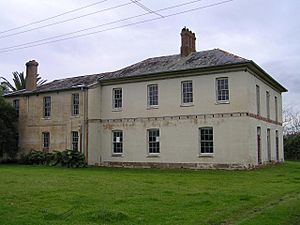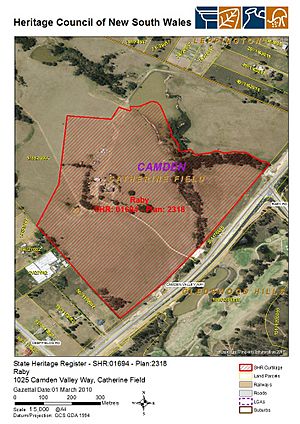Raby, Catherine Field facts for kids
Quick facts for kids Raby |
|
|---|---|
 |
|
| Location | 1025 Camden Valley Way, Catherine Field, Camden Council, New South Wales, Australia |
| Built | 1820–1834 |
| Official name: Raby | |
| Type | State heritage (landscape) |
| Designated | 1 March 2010 |
| Reference no. | 1694 |
| Type | Historic Landscape |
| Category | Landscape - Cultural |
| Lua error in Module:Location_map at line 420: attempt to index field 'wikibase' (a nil value). | |
Raby is a very old farm and home located in Catherine Field, a suburb in south-western Sydney, Australia. It was once a large farm for sheep and cattle. The main house and other buildings were built between 1820 and 1834. Today, Raby is a private home and is listed on the New South Wales State Heritage Register because of its important history.
Contents
Discovering Raby: A Historic Farm
The Story of the Cowpastures
When the first European settlers arrived in Sydney Cove in 1788, they found the land wasn't good for farming. They soon looked west to the Cumberland Plain, where the soil was much better. Early farms were set up near rivers like the Nepean and Hawkesbury.
By 1804, much of the Cumberland Plain was settled. Governor King then looked for more good land. He found an area called the Cowpastures in the southwest. This area got its name because cows from the first fleet had wandered off and were found there in 1795. The government had kept this land empty to let the wild cattle grow in number.
In 1803, Governor King and his wife visited the Cowpastures. Mrs. King was the first "white lady" to cross the Nepean River. A road was later built to this area, which became known as Cowpasture Road. Today, parts of it are called Camden Valley Way.
Many important people wanted land in the Cowpastures because it was great for grazing animals. Captain Henry Waterhouse described it as a "beautiful park" with "rich luxuriant grass." Early Europeans thought the flat areas were perfect for cattle and the hills for sheep. They liked that there wasn't much undergrowth, which was probably due to Aboriginal people burning off the land.
John Macarthur, a key figure in Australia's early wool industry, received the first large land grant in the Cowpastures in 1805. He was given 4,047 hectares (10,000 acres) of land. He also arranged for a friend to get 809-hectare (2,000-acre), which Macarthur then used. This meant he controlled a huge area of land along the river.
How Raby Farm Began
The Raby property, which was 1,214 hectares (3,000 acres) (about 3,000 acres), was given to Alexander Riley in 1816. Alexander Riley was a successful trader and farmer, especially with sheep. He was very interested in improving the quality of wool.
In 1817, Alexander Riley returned to England. His nephew, Edward Riley, came to Australia in 1825 with 200 special Saxon merino sheep from Germany. Even though the farm buildings had been neglected and there was a drought, Edward helped the sheep herd grow. For three years, Raby's Saxon sheep won awards at agricultural shows.
The first house at Raby was built around 1820. It was a simple farmhouse in a cleared field, surrounded by eucalyptus trees. It was considered one of the best houses in the area at the time. This first house was likely located where the current house stands.
By 1830, Alexander's son, William Edward Riley, took over managing Raby. The family's sheep farming was very successful. In 1834, Raby was known as one of the most famous farms in the colony.
Changes and New Owners
Sadly, William Riley died in a riding accident in 1836. The Riley family owned Raby until 1866, but they leased it to different people.
The Moore family became the next owners of Raby. Edward Moore and his wife Elizabeth were sent to Australia in the early 1800s. Edward worked hard and became very successful. By 1835, he was leasing Raby and doing very well. The Moore family even hosted Governor FitzRoy for hunting trips at Raby.
A map of Raby from 1866 shows it was 1,331 hectares (3,289 acres) in size. The Moore family made improvements, like clearing land and building fences. They ran Raby as a mixed farm, growing crops and raising animals.
The main house you see today was built around 1875. The original 1820 house was kept for a while and used as a kitchen. Old photos show how the house looked in the 1880s and 1890s, with beautiful gardens and climbing roses.
After William Moore passed away in 1905, parts of the Raby estate were sold off. The Mitchell family bought the main homestead in 1935 and continued to raise Merino sheep and Hereford cattle. The Mitchell family owned Raby until 2003.
Today, the Raby estate is smaller than it used to be, but it's still a special place. The homestead overlooks a creek, surrounded by hills, showing what a large farm looked like in the past.
Exploring Raby: What You Can See
Raby still has farmland next to a small creek and Camden Valley Way. The main house is set back from the road, reached by a curving driveway.
Farm Features
You can still see many old farm elements at Raby:
- A small burial ground or cemetery on a hill.
- The main house, built around 1875.
- Other old buildings.
- Paddocks (fields for animals).
- The entrance gate and fences that show the original boundary of the farm.
The old fence lines and farm layout are still visible in the fields. Tall she oak trees grow along Riley's Creek, which is near the house. You can also find small areas of original Cumberland Plain Woodland, which is a special type of forest. Some very old trees stand along Camden Valley Way.
There are great views of the house and farm from different spots, just like in old drawings and photos.
Old Buildings and Garden
Some old buildings remain at Raby. While the very first house and a large barn are gone, a brick cottage that was once part of the 1820s homestead complex still stands. It later became the house's kitchen.
The garden around the house has many old plants. In 1990, it had tall trees and some old garden beds. You can still see plants like native cypress pines, stone pines, and Canary Island palms. There are also hedges and flowering plants like Cape plumbago and red hot pokers.
Near the house, you might find old garden bed tiles and drainage tiles. A beehive-shaped well is also still there in the lawn.
The Main House
The main house, built around 1875, is a grand two-story building made of painted brick. It has a low, sloping slate roof and several brick chimneys. It used to have two levels of verandas with fancy ironwork, but these were removed later. The house still has its original windows and an impressive front door.
A two-story service wing, which was used for things like servants' quarters or storage, is attached to the back of the house.
Condition and Changes
In 2003, the house and other buildings were in poor condition. However, Raby is important for understanding the past, especially because there might be remains of the original 1820s house underground.
Even though the original land has been divided, the main house is still on part of the land granted in 1816.
Over the years, Raby has seen many changes:
- 1816: Alexander Riley received the land grant.
- Around 1820: The first house was built.
- 1866: The Moore family became the owners.
- Around 1875: The current main house was built.
- 1905: Much of the original land was sold off.
- 1935: The Mitchell family took over the property.
- Late 20th Century: The iron verandas were removed.
- 2009/2010: A new owner began repairs, including replacing the roof and fixing the electricity.
Why Raby is Important
Raby is a rare example of an early colonial farm estate that still exists today. It is very important to the history of New South Wales because it played a big part in starting Australia's fine merino wool industry.
Raby is also part of a group of important old farms along the former Cowpastures Road. It shows what early colonial farms were like. The house is still on land from the original 1816 grant.
The farm has strong connections to the Riley and Moore families, who were important in its history. Many famous people, like artists Joseph Lycett and William Hardy Wilson, and writers Baron Von Hugel and Dr. John Lhotsky, have featured Raby in their works.
Raby is listed on the New South Wales State Heritage Register because:
- It shows the history of the fine merino wool industry in New South Wales.
- It has strong links to important people and families like the Rileys and Moores.
- It has a beautiful landscape that is still visually striking from the old roads.
- It is important to the community for its role in Australia's wool industry.
- It can help us learn more about colonial farming and landscape design through archaeological research.
- It is a rare example of an early colonial estate in the Cumberland Plain.
- It represents a typical early colonial farming estate in New South Wales.





